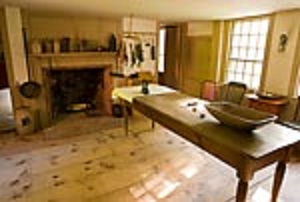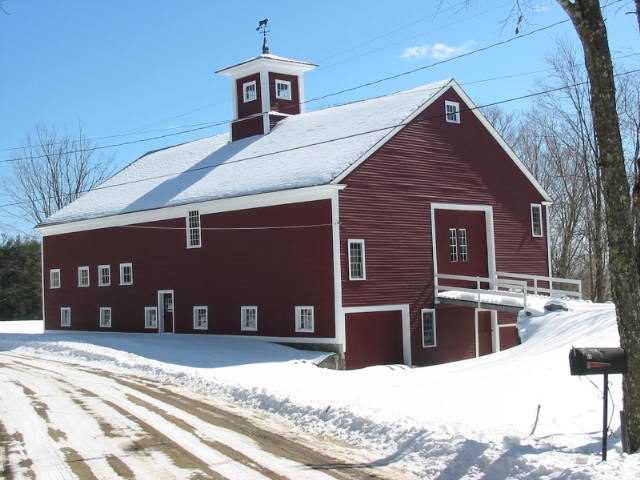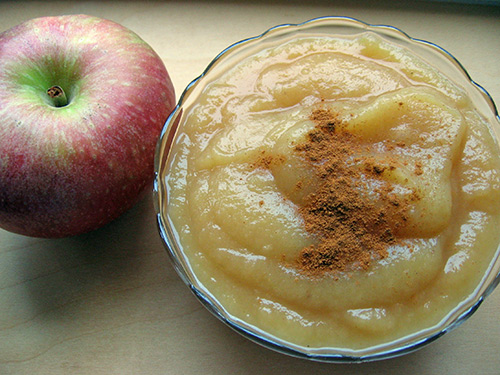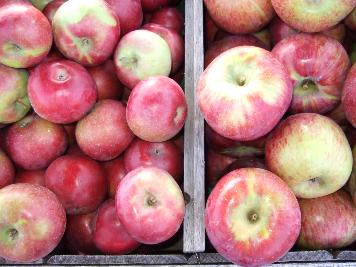
New Hampshire Marlborough Pie (Cooking Light Magazine picture)

Massachusetts is the big, important state which dominates New England.
Tell that to New Hampshire. When it comes to Marlborough Pie, at least, New Hampshire has the granite edge on the Bay State.
Kevin Stavely and Kathleen Fitzgerald, authors of Northern Hospitality: Cooking by the Book In New England (2011) write that “the first time the name ‘Marlborough’ is associated with the dish is, as far as we can determine, in an American source, namely Amelia Simmons’s American Cookery (1796). In other words, the invented name is a nod to the dish’s English pedigree.” Perhaps that is true – but new Hampshire still has a stronger claim to it as the state pie than does Massachusetts.

The Pierce Homestead kitchen in Hillsborough, New Hampshire.
Although Marlborough Pie is often thought of as a specialty of Massachusetts (even called “Boston Marlborough Pie” by…who else, Bostonians), a little picking makes a strong case that it was popularized in New Hampshire and named for the town of Marlborough, New Hampshire and not Marlboro, Massachusetts. There were and continue to be exponentially more apple orchards in the region of the tiny, Cheshire County New Hampshire village than there ever were in Boston or even the same-named town in the Bay State. It was also a favorite in the household of Governor Benjamin Pierce of Hillsborough, in the next county, to the east, of Marlborough – who had also established himself there before 1796, when Simmons left the first written record of such a pie.

Main Street Marlborough, old-school.
Originally an outpost fort, it was settled in 1764 and originally called Oxford, but either the influx there of settlers from Marlborough, Massachusetts, forced the name change or it too was named to honor England’s First Duke of Marlborough.
Even early on, however, the Don’t Tread on Me crowd was pulling its weight in stone for Massachusetts.

Don’t Tread on Me granite.

Old Man Mountain.
Marlborough once boasted the output of New Hampshire’s most important product. Nothing says New Hampshire more than its famous granite, an important state symbol being the profile of an old man formed by stone known as Old Man Mountain.
Marlborough’s quarries were carved up and its contents carried across the state line to build the Boston area, its granite forming the foundations of structures from Worcester’s College of the Holy Cross to the Frost Free Library (as in a person named Frost, not as in ice cream without ice).

Marlborough’s picturesque Cardillo Barn.
Picturesque Marlborough once kept the nation warm in winter and its children happy all year with manufacturing of blankets and toys.

Heritage apples growing on trees in the Monadrock area of new Hampshire, not far from Marlborough. (geekdoctor.blogspot.com)
Located in the region dominated by Mount Monadnock, the area still boasts a thriving range of apple orchards where the fruit can not only be purchased directly but picked in the harvest season.
Many of the heritage varieties of apples there, some of the oldest continuously grown in the country, nevertheless begin their ripening as early as late July.
If the apples aren’t picked, they fall. If they fall, they rot. And even among those who are ready to harvest later, the thin skins mean they don’t store long before also rotting.

Homemade applesauce. (www.zehnders.com)
To the notorious skin-flints of the Granite State, that’s a useless waste of good apples.
One of the easiest and oldest ways to make good use of them was to either slice them up or boil them down into applesauce, then bottle or can the applesause for a cold weather months that can stretch from October to April. Which is why applesauce is the base ingredient for Marlborough Pie. It’s not an apple pie nor a custard pie, but something like an apple custard pie.

Apples of Alysons Orchard. (www.alysonsorchard.com)
Traditionalists insist a Marlborough Pie takes on a whole life of its own when freshly homemade applesauce is used. The process is simple enough, requiring the peeling, quartering and coring of about four pounds of apples, boiled with about a 1/2 cup of brown and white sugar, but adjusted to taste, cinnamon and the juice of one lemon. It all gets simmered down for about a half hour, and then mashed well together – yielding about two cups for the pie. In deciding what type of apple to use to make the sauce, there is a wide range of good choices, a guide to which can be found at the website of Alyson’s Orchard in the Monadnock region (http: www.alysonsorchard.com). What is also unusually traditional is that Marlborough Pie is baked in a puff pastry crust.
And the heavy splash of sherry or Madeira Wine gives it a great nutty taste.
Regardless of whether one makes applesauce or uses a good store brand, the puff pastry is easily found at most stores including good old Trader Joe’s. It has to be defrosted and then pressed into a low, scalloped ceramic pie dish. The pie itself is easy and bakes quickly:
Marlborough New Hampshire Pie

Marlborough New Hampshire Pie (stavelyandfitzgerald.com)
2 cups of applesauce
1/3 cup of sugar
3 eggs
1/2 cup butter
1/2 cup heavy cream
1/4 cup sherry or Madeira wine
Puff Pastry
Pour sugar over fruit and mix well. Line the pie plate with puff pastry. Beat eggs until blended, then add butter and heavy cream until thoroughly blended. Finally, blend the custard mix with the sweetened applesauce and the sherry or Madeira Wine, and pour into pie shell. Bake at 400 degrees for 15 minutes, then reduce temperature to 350 and bake for 45 minutes or until a knife emerges clean from the custard. Cool to room temperature or refrigerate before serving.
Categories: Food, Regional Food, Regionality, State Pies
Tags: Cheshire County New Hampshire, Marlborough, Marlborough Massachusetts, Marlborough Pie, New England, New Hampshire, New Hampshire Marlborough, Old Man Mountain
 A President in Alaska: Ninety Rare Images of Harding’s Fatal Trip
A President in Alaska: Ninety Rare Images of Harding’s Fatal Trip  Betty Draper, Brach’s Easter Candy & Sugar Daddy
Betty Draper, Brach’s Easter Candy & Sugar Daddy  Top Ten Weird Easter Candies
Top Ten Weird Easter Candies  “A Nation without Cranberry Sauce!” The Red Relish Panic of Thanksgiving 1959
“A Nation without Cranberry Sauce!” The Red Relish Panic of Thanksgiving 1959  Empire State Violet Pie: A Victorian New York Florality
Empire State Violet Pie: A Victorian New York Florality  Once Banned in Boston: Mince No Pie in the Old Bay State
Once Banned in Boston: Mince No Pie in the Old Bay State
Can’t wait to try this one. Looks so… YUMMYLICIOUS!!!
It is – and not at all like an apple pie – very much its own thing. Thanks for writing…
Just what I needed… Another delicious pie recipe! I hadn’t heard of Marlborough Pie before this. I am not a huge fan of apple pie (exception made for the giant slices in that pink and gold and white restaurant in the middle of Disneyland, but everything would have to taste better at Disneyland), but this look really good. And homemade applesauce can’t be beat. I made some last fall out of Gravenstein apples that I’d picked myself at a local orchard. More of the benefits of living in Oregon!
Now, the big question… are you a pie baker or just a pie eater?
Another great post!
Jake
I admit to both baking and eating pie – I do try all of these Pies of the State, or have tried them. I admit no patience with making crust, and rely on the high-quality Trader Joe crust. There’s something unusual about this pie – not at all like apple pie, since it doesn’t have spices.
Don’t forget FLUFF, as you may well know it is a staple in most kitchens in Boston!
It would taste great on a fresh baked Marlborough New Hampshire pie, or anything for that matter! Naturally fat free, and brings back so many wonderful memories…
🙂
http://www.marshmellowfluff.com/pages/history1.html
You must be a mind-reader. I am rabidly Pro-Fluff on everything except hamburgers. It is now being distributed in California as well, so no more pony-express delivery from Massachusetts is necessary. I appreciate very much your writing – and your brilliant and wise suggestion. It is my hope that someday we shall truly be a Marshmallow Fluff nation. It is only egg whites and sugar.
Wasn’t Franklin Pierce from NH originally? Was he related to Benjamin Pierce? Franklin was kind of an odd character, and poor Jane Appleton, what she went through!
Yes – Benjamin Pierce was his father and he and Jane were said to have enjoyed Sparking Pie, which is similar to Marlborough Pie. Pretty good memory there – thanks very much for writing. I will have the other 47 states and their state pies on here, one by one. Stay tuned! Thanks again for writing.